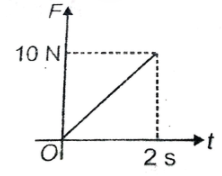A force of 10 N acts on a body of mass 2 kg for 3s , initially at rest. Calculate change in momentum of the body.
To solve the problem step by step, we will follow these calculations:
Step 1: Identify the given values
- Force (F) = 10 N
- Mass (m) = 2 kg
- Time (t) = 3 s
- Initial velocity (u) = 0 m/s (since the body is initially at rest)
Step 2: Calculate acceleration using Newton's second law
According to Newton's second law, the force acting on an object is equal to the mass of the object multiplied by its acceleration:
F=m⋅a
Rearranging this formula to find acceleration (a):
a=Fm
Substituting the known values:
a=10N2kg=5m/s2
Step 3: Calculate the final velocity using the first equation of motion
The first equation of motion states:
v=u+a⋅t
Substituting the known values:
v=0+(5m/s2)⋅(3s)
v=15m/s
Step 4: Calculate the initial momentum
Momentum (P) is given by the formula:
P=m⋅v
For initial momentum (P_initial):
Pinitial=m⋅u=2kg⋅0m/s=0kg m/s
Step 5: Calculate the final momentum
For final momentum (P_final):
Pfinal=m⋅v=2kg⋅15m/s=30kg m/s
Step 6: Calculate the change in momentum
Change in momentum (ΔP) is given by:
ΔP=Pfinal−Pinitial
Substituting the values:
ΔP=30kg m/s−0kg m/s=30kg m/s
Final Answer
The change in momentum of the body is 30 kg m/s.
---
- Force (F) = 10 N
- Mass (m) = 2 kg
- Time (t) = 3 s
- Initial velocity (u) = 0 m/s (since the body is initially at rest)
According to Newton's second law, the force acting on an object is equal to the mass of the object multiplied by its acceleration:
F=m⋅a
Rearranging this formula to find acceleration (a):
a=Fm
a=10N2kg=5m/s2
The first equation of motion states:
v=u+a⋅t
Substituting the known values:
v=0+(5m/s2)⋅(3s)
v=15m/s
Momentum (P) is given by the formula:
P=m⋅v
For initial momentum (P_initial):
Pinitial=m⋅u=2kg⋅0m/s=0kg m/s
For final momentum (P_final):
Pfinal=m⋅v=2kg⋅15m/s=30kg m/s
Change in momentum (ΔP) is given by:
ΔP=Pfinal−Pinitial
Substituting the values:
ΔP=30kg m/s−0kg m/s=30kg m/s
The change in momentum of the body is 30 kg m/s.
Topper's Solved these Questions
- BOOK - ICSECHAPTER - LAWS OF MOTIONEXERCISE - TOPIC 3 (2 Marks Questions )9videos
LAWS OF MOTION
- BOOK - ICSECHAPTER - LAWS OF MOTIONEXERCISE - TOPIC 3 (3 Marks Questions )7videos
LAWS OF MOTION
- BOOK - ICSECHAPTER - LAWS OF MOTIONEXERCISE - TOPIC 2 (3 Marks Questions )11videos
LAWS OF MOTION
- BOOK - ICSECHAPTER - ICSE ANNUAL EXAMINATION -2020EXERCISE - SECTION-II45videos
ICSE ANNUAL EXAMINATION -2020
- BOOK - ICSECHAPTER - LIGHTEXERCISE - TOPIC 2 Spherical Mirrors (4 Marks Questions )9videos
LIGHT
Similar Questions
A force of 10 N acts on a body of mass 2 kg for 3s , initially at rest. Calculate the velocity acquired by the body
View SolutionA force of 10 N acts on a body of mass 0.5 kg for 0.25s starting from rest.What is its momentum now?
View SolutionA force of 10 N acts on a body of mass 5 kg. Find the acceleration produced.
View SolutionA force of 15 N acts on a body of mass 2 kg. Calculate the acceleration produced.
View SolutionA force of 15 N acts on a body of mass 2 kg. Calculate the acceleration produced.
View SolutionA variable force acts on a body of mass 2 kg intially at rest as shown in figure . Calculate the impulse of the force in first 2 seconds and speed of the body after 2 seconds .
 View Solution
View SolutionA force acts for 0.1 s on a body of mass 1.2 kg initially at rest. The force then ceases to act and the body moves thorugh 2 m in the next 1.0 s . Find the magnitude of force.
View SolutionA force of 10 Newton acts on a body of mass 20 kg for 10 seconds. Change in its momentum is
View SolutionA force acts for 0.1 s on a body of mass 2.0 kg initially at rest. The force is then withdrawn and the body moves with a velocity of 2m s−1. Find the magnitude of the force.
View SolutionA force acts for 0.1 s on a body of mass 2 kg initially at rest. The force is then withdrawn and the body moves with a velocity of 2 m/s. Find the magnitude of force.
View Solution

